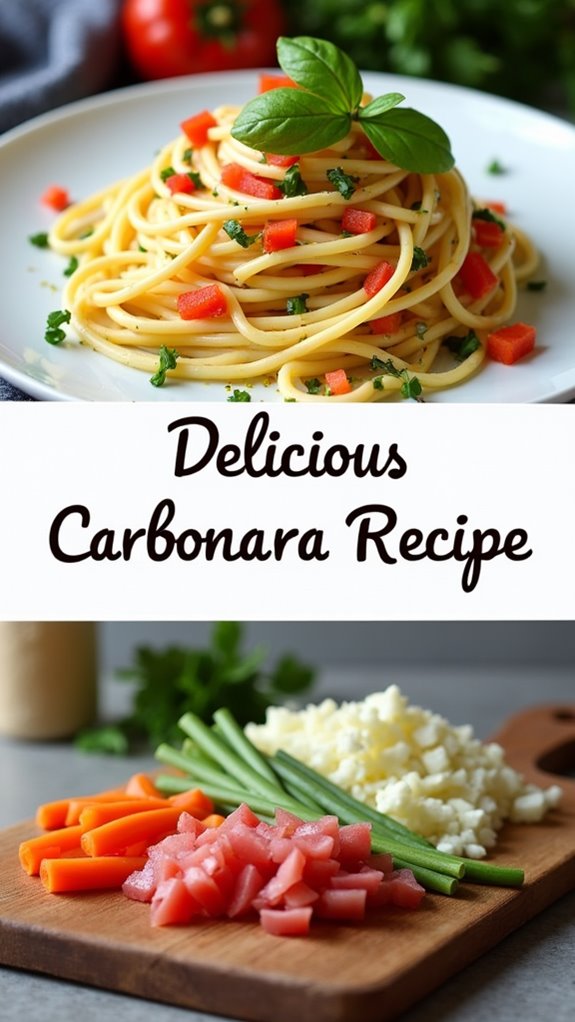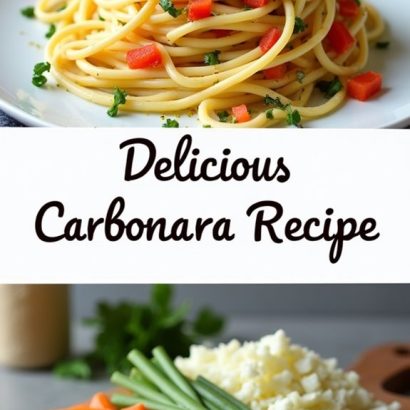Food Recipes
Did you know that the concept of recipes dates back to ancient Mesopotamia, where early cooks etched them onto clay tablets? These recipes have evolved considerably over the centuries, shaping the way we cook today. Whether you’re looking to whip up a quick meal or impress guests with a complex dish, understanding the history and structure of recipes can enhance your cooking skills. Discover how these culinary traditions can transform your kitchen experience.
Why You’ll Love This Recipe
When you try this recipe, you’ll quickly see why it’s a favorite among many home cooks. It combines simple ingredients that you probably already have in your pantry, making it easy to whip up any day of the week.
The cooking process is straightforward, allowing you to follow each step without getting overwhelmed. Plus, the flavors blend beautifully, creating a delicious dish that everyone will enjoy.
You can easily customize it, adding your favorite vegetables or spices to suit your taste. This recipe isn’t only tasty, but it’s also versatile, perfect for any meal.
You’ll appreciate how quickly it comes together, giving you more time to enjoy with family or friends. Your kitchen will smell amazing!
History
The history of food recipes dates back thousands of years, showcasing how cooking has evolved over time. You can trace early recipes to ancient civilizations, where people documented their cooking methods on clay tablets.
These early guides helped spread culinary knowledge among cultures. As time went on, recipes transformed, adapting to regional ingredients and tastes. In medieval Europe, cookbooks became popular, offering detailed instructions for various dishes.
The invention of the printing press helped share recipes widely, making them accessible to more people. Today, you can find countless recipes online, reflecting diverse cultures and modern cooking techniques.
Understanding this history enriches your cooking experience, giving you a deeper appreciation for the meals you prepare and enjoy with others.
Recipe

Ingredients:
– 400g spaghetti
– 150g pancetta or guanciale, diced
– 3 large eggs
– 100g Pecorino Romano cheese, grated
– Freshly cracked black pepper
– Salt (for pasta water)
– Fresh parsley (optional, for garnish)
Cooking Instructions:
- Bring a large pot of salted water to a boil. Add the spaghetti and cook according to package instructions until al dente, usually about 8-10 minutes. Reserve about 1 cup of pasta water before draining the spaghetti.
- While the pasta is cooking, heat a large skillet over medium heat. Add the diced pancetta or guanciale and cook until it’s crispy and golden brown, about 5-7 minutes. Remove from heat and set aside, keeping it warm.
- In a mixing bowl, whisk together the eggs, grated Pecorino Romano cheese, and a generous amount of freshly cracked black pepper until well combined. Set aside.
- Once the spaghetti is cooked and drained, immediately add it to the skillet with the warm pancetta, tossing to combine. Make sure the pasta is hot enough to cook the eggs without scrambling them.
- Remove the skillet from heat, and quickly pour the egg and cheese mixture over the hot pasta, tossing vigorously to coat the spaghetti evenly. If the sauce seems too thick, add reserved pasta water a little at a time until you achieve your desired creaminess.
- Serve immediately, garnished with additional Pecorino Romano and freshly cracked black pepper. Optionally, sprinkle with chopped fresh parsley for a pop of color.
Extra Tips:
To elevate your Carbonara, consider using fresh homemade pasta if possible, as it cooks faster and adds a delightful texture.
Always have your ingredients prepped and ready before you start cooking, as timing is essential to prevent the eggs from scrambling.
Additionally, for a twist, you can experiment by adding sautéed garlic or adding peas for a pop of color and sweetness.
Remember that the key to a great Carbonara is quality ingredients and a little bit of love in the cooking process!
Final Thoughts
As you wrap up your cooking adventure with this delicious Carbonara, remember that mastering this dish is all about practice and attention to detail.
Pay close attention to the timing of your pasta; it should be al dente, not mushy. When combining the eggs and cheese, mix quickly to create a creamy sauce without scrambling the eggs.
Taste your dish before serving—seasoning can make a significant difference. Don’t forget to add fresh cracked pepper for that classic touch.
Enjoy the process, and don’t be afraid to experiment with ingredients or flavors that you love. Each time you make Carbonara, you’ll learn something new, bringing you closer to perfection.
Happy cooking, and enjoy your meal!
FAQ
When you’re making Carbonara, you might wonder about some common questions that can pop up during the cooking process.
First, can you use cream? Traditional recipes don’t include it, so stick with eggs for that creamy texture.
Next, what type of pasta should you use? Spaghetti is classic, but fettuccine or bucatini also work well.
If you’re concerned about the eggs scrambling, remember to mix them off the heat and work quickly.
You might also ask about the bacon; pancetta is preferred, but guanciale or even bacon can be used.
Finally, how do you achieve the right consistency? Gradually add pasta water to adjust the sauce.
These tips will help you create a delicious Carbonara!

FOOD RECIPES
Ingredients
- Ingredients:
- - 400g spaghetti
- - 150g pancetta or guanciale diced
- - 3 large eggs
- - 100g Pecorino Romano cheese grated
- - Freshly cracked black pepper
- - Salt for pasta water
- - Fresh parsley optional, for garnish
Instructions
- Cooking Instructions:
- Bring a large pot of salted water to a boil. Add the spaghetti and cook according to package instructions until al dente, usually about 8-10 minutes. Reserve about 1 cup of pasta water before draining the spaghetti.
- While the pasta is cooking, heat a large skillet over medium heat. Add the diced pancetta or guanciale and cook until it's crispy and golden brown, about 5-7 minutes. Remove from heat and set aside, keeping it warm.
- In a mixing bowl, whisk together the eggs, grated Pecorino Romano cheese, and a generous amount of freshly cracked black pepper until well combined. Set aside.
- Once the spaghetti is cooked and drained, immediately add it to the skillet with the warm pancetta, tossing to combine. Make sure the pasta is hot enough to cook the eggs without scrambling them.
- Remove the skillet from heat, and quickly pour the egg and cheese mixture over the hot pasta, tossing vigorously to coat the spaghetti evenly. If the sauce seems too thick, add reserved pasta water a little at a time until you achieve your desired creaminess.
- Serve immediately, garnished with additional Pecorino Romano and freshly cracked black pepper. Optionally, sprinkle with chopped fresh parsley for a pop of color.
